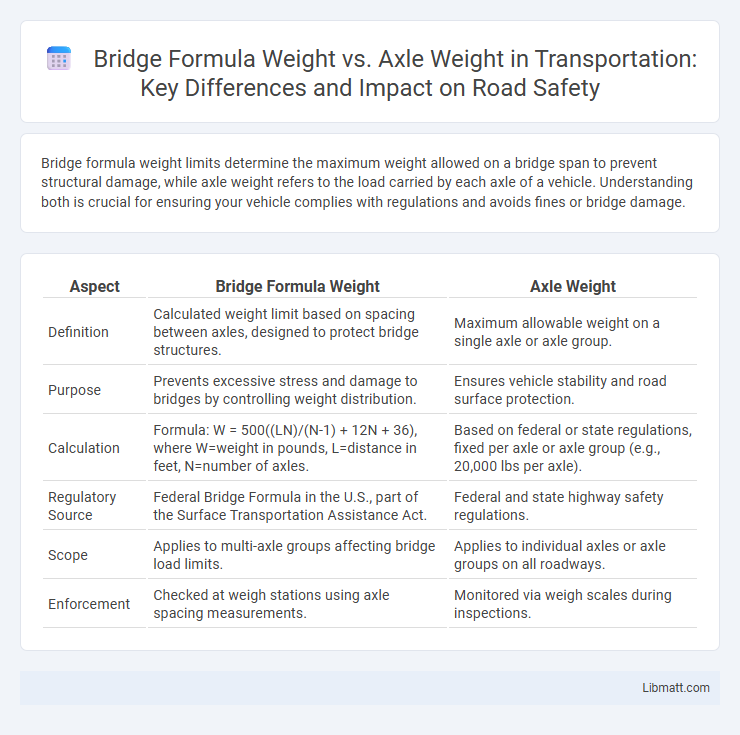Bridge formula weight limits determine the maximum weight allowed on a bridge span to prevent structural damage, while axle weight refers to the load carried by each axle of a vehicle. Understanding both is crucial for ensuring your vehicle complies with regulations and avoids fines or bridge damage.
Table of Comparison
| Aspect | Bridge Formula Weight | Axle Weight |
|---|---|---|
| Definition | Calculated weight limit based on spacing between axles, designed to protect bridge structures. | Maximum allowable weight on a single axle or axle group. |
| Purpose | Prevents excessive stress and damage to bridges by controlling weight distribution. | Ensures vehicle stability and road surface protection. |
| Calculation | Formula: W = 500((LN)/(N-1) + 12N + 36), where W=weight in pounds, L=distance in feet, N=number of axles. | Based on federal or state regulations, fixed per axle or axle group (e.g., 20,000 lbs per axle). |
| Regulatory Source | Federal Bridge Formula in the U.S., part of the Surface Transportation Assistance Act. | Federal and state highway safety regulations. |
| Scope | Applies to multi-axle groups affecting bridge load limits. | Applies to individual axles or axle groups on all roadways. |
| Enforcement | Checked at weigh stations using axle spacing measurements. | Monitored via weigh scales during inspections. |
Understanding Bridge Formula Weight
Bridge formula weight regulates the maximum allowable weight per axle or axle group to prevent excessive stress on highway bridges. It calculates load limits based on axle spacing and total weight, ensuring your vehicle complies with safety standards and reduces risk of bridge damage. Understanding these limits helps optimize cargo distribution and avoid costly penalties during transportation.
What is Axle Weight?
Axle weight refers to the total weight exerted on a single axle of a vehicle, including the weight of the vehicle itself and any load it carries. Measuring axle weight is critical for ensuring road safety and compliance with legal weight limits, as excessive axle weight can cause road damage and lead to fines. Your vehicle's axle weight must be within specified limits to avoid penalties and protect infrastructure.
Key Differences Between Bridge Formula Weight and Axle Weight
Bridge formula weight regulates the maximum load distributed across multiple axles to protect bridge infrastructure from excessive stress, while axle weight refers to the load carried by a single axle. Bridge formula weight limits depend on the spacing between axles and total vehicle length, ensuring the load is spread to prevent structural damage. Understanding these distinctions helps you comply with transportation regulations and avoid costly fines or infrastructure damage.
Why Does the Bridge Formula Matter?
The Bridge Formula matters because it regulates the distribution of weight across multiple axles to prevent excessive stress on highways and bridges. By limiting axle weight relative to the spacing between axles, it ensures infrastructure durability and reduces the risk of costly repairs due to damage from overloaded vehicles. Proper enforcement of the Bridge Formula protects public investments and maintains safe road conditions for all users.
Calculating Bridge Formula Weight
Calculating bridge formula weight involves determining the maximum allowable weight on a vehicle's axles to prevent damage to highway bridges. The formula accounts for the number and spacing of axles, distributing total weight to ensure structural integrity by limiting load concentration. Accurate calculations help enforce legal weight limits, enhancing road safety and infrastructure longevity.
Axle Weight Limits and Regulations
Axle weight limits are critical regulations designed to prevent road damage and ensure safety by restricting the maximum weight each axle of a vehicle can carry. The bridge formula weight dictates how total vehicle weight must be distributed across multiple axles to protect bridges and roadways from excessive stress. Understanding these legal weight limits helps you avoid fines and infrastructure damage while maintaining compliance with transportation safety standards.
Effects of Exceeding Weight Limits
Exceeding bridge formula weight limits increases the risk of structural damage, reducing bridge lifespan and compromising safety. Excessive axle weight can cause concentrated stress, leading to cracks, deformation, and potential bridge failure. You must comply with weight regulations to prevent costly repairs, fines, and hazards to public safety.
Bridge Safety and Infrastructure Concerns
Bridge formula weight limits regulate the maximum load distributed across axles to minimize stress on bridge structures, preventing premature wear or potential failure. Exceeding the axle weight increases the risk of cracking, deflection, and long-term damage to bridge components, compromising overall safety. Understanding your vehicle's compliance with bridge formula limits is crucial to preserving infrastructure integrity and avoiding costly repairs.
Strategies to Comply with Weight Regulations
Implementing load distribution techniques such as tandem axle grouping and lift axles helps reduce axle weight and comply with bridge formula requirements. Utilizing advanced telematics and weight sensors enables real-time monitoring of vehicle weight to prevent overweight violations. Regular route planning to avoid weight-restricted bridges minimizes risk and ensures adherence to state and federal weight regulations.
Common Mistakes and Best Practices
Confusing bridge formula weight with axle weight often leads to incorrect load distribution assessments that can cause infrastructure damage or legal penalties. Accurately calculating the bridge formula weight involves considering the spacing and number of axles, unlike axle weight which measures load per single axle, so misinterpretation can result in noncompliance with bridge load limits. Best practices include using precise measurements and specialized software tools to ensure compliance with federal and state regulations, thereby protecting bridges while optimizing vehicle load capacities.
bridge formula weight vs axle weight Infographic

 libmatt.com
libmatt.com